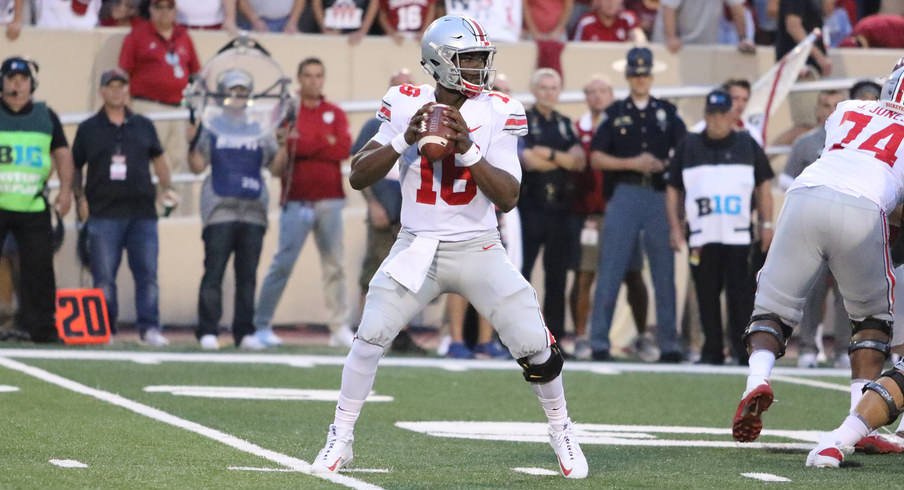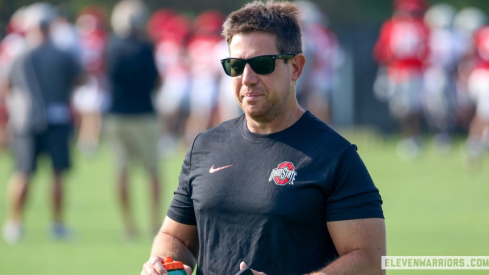BLOOMINGTON, Ind. – While Ohio State’s performance against Indiana on Thursday night wasn’t always pretty, the final numbers ended up looking impressive.
The Buckeyes covered the spread by a full touchdown, winning Thursday night’s game by a score of 49-21 while putting up 596 yards of offense in Kevin Wilson’s first game as offensive coordinator.
The most notable number of the night might have been 181 – that being the number of rushing yards by Ohio State freshman running back J.K. Dobbins, breaking the record for the most rushing yards by a player in his first Buckeyes game (previously held by Maurice Clarett, who had 175 yards in his 2002 debut).
That said, we’ve already covered Dobbins’ historic night in detail, so let’s take a look at three other statistics that played a key role in the Buckeyes’ season-opening win.
J.T. Barrett throws for 304 yards
For the first time since he threw for 349 yards in last year’s season opener against Bowling Green, Ohio State quarterback J.T. Barrett eclipsed the 300-yard mark as a passer on Thursday night.
A cursory look at that statistic would suggest that Barrett, who had never previously thrown for more than 302 yards in a game against a Big Ten opponent, performed better as expected in the passing game than he did last year. A closer look at reality shows that Barrett, who completed 20 of his 35 passing attempts on Thursday night, remained inconsistent throwing the ball downfield. He missed his fair share of open receivers throughout the game, while his statistics were padded significantly by Parris Campbell’s 74-yard touchdown and Johnnie Dixon’s 59-yard touchdown, both of which resulted from long runs after the catch.
On the other hand, Barrett was also let down by his receivers at times, including a perfectly thrown deep ball to Campbell that should have been a 41-yard touchdown pass but was dropped.
Barrett had only 95 passing yards in the first half – a big reason why the Buckeyes had only 13 points and trailed at halftime – but the fact that he ultimately surpassed the 300-yard mark was a huge factor in Ohio State ultimately scoring 49 points.
Indiana runs for only 17 yards
Ohio State’s defense allowed 420 passing yards on Thursday night, the most the Buckeyes have allowed in a single game since they allowed 451 yards at Michigan in 2013. With three new starters in their secondary from last season, Ohio State’s passing defense certainly struggled against Indiana quarterback Richard Lagow and a talented stable of Hoosiers receivers, led by Simmie Cobbs, who had 11 catches for 149 yards and a touchdown.
The biggest reason why the Hoosiers passed for so many yards, though, was that they threw the ball 65 times – an Indiana school record for most passing attempts in a single game.
The biggest reason why the Hoosiers attempted so many passes wasn’t because they were having so much success through the air, but because they had no success on the ground.
Ohio State held the Hoosiers to just 17 net rushing yards on 27 rushing attempts, not allowing a single run of 10 yards or more for the entire game. As the Hoosiers’ passing offense began to lose its steam in the second half, Ohio State’s defensive front continued to stifle the Hoosiers’ running game, which ultimately led to the home team’s demise.
Ohio State wins the turnover battle 3-0
If there’s one statistic Ohio State’s coaches are sure to be happy about from Thursday night's game, it’s that the Buckeyes didn’t have a single turnover, marking the first time Ohio State kept a clean sheet in that category in a season opener since 2012.
Indiana, on the other hand, had three turnovers, and the Buckeyes capitalized on all three.
Jordan Fuller intercepted a pass in the end zone off a Kendall Sheffield deflection early in the second quarter, which provided a much-needed boost of momentum and kept the Buckeyes from going two scores. Fuller returned the interception to the 40-yard line, which helped set up a field goal.
A forced fumble on a strip sack by Jashon Cornell was recovered at Indiana’s own 11-yard line by Jonathan Cooper, which led to a touchdown pass from Barrett to Binjimen Victor on the very next play.
The Buckeyes drove 87 yards for their final touchdown of the game after an interception at their own 13-yard line by Denzel Ward.
By scoring 17 points off of three forced turnovers, while taking scoring opportunities away from the Hoosiers on both interceptions, Ohio State truly swung the game into its lopsided favor by winning the turnover battle.


